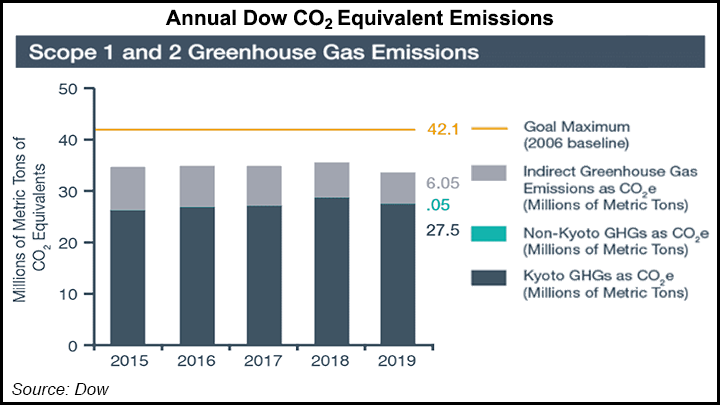Regulatory | NGI All News Access
Dow Aiming to Stop Plastic Waste, Lower GHG Emissions

Dow Inc. has outlined a series of initiatives in order to combat plastic waste and achieve carbon neutrality by 2050.
In its recently issued 2019 Sustainability Report, Michigan-based Dow said that by 2030, it would reduce its net annual carbon emissions by 5 million metric tons (mmt), or 15% from its 2020 baseline. Additionally, the petrochemicals company indicated that it would implement and advance technologies to manufacture products using fewer resources and help customers reduce their carbon footprints.
During that time, Dow aims to help “stop the waste” by enabling 1 mmt of plastic to be collected, reused or recycled through direct actions and partnerships. The company is investing and collaborating in key technologies and infrastructure to significantly increase global recycling.
By 2035, Dow strives to help “close the loop” by having 100% of its products sold into packaging applications be reusable or recyclable.
“Climate change and plastic waste are among the greatest technical, social and economic issues the world has ever faced, and our products and technology are critical to addressing both,” said CEO Jim Fitterling. “At Dow, we have a responsibility and an opportunity to lead in addressing these global challenges. A sustainable future is attainable, but only if we continue to tackle these issues head-on, hold ourselves accountable and work together to enable new science- and technology-based solutions that directly address both climate change and plastic waste.”
Earlier this month, Dow entered into renewable power agreements for its manufacturing facilities in Argentina, Brazil, Texas, and Kentucky, securing 338 MW of additional power capacity from renewable sources, representing an expected reduction of more than 225,000 metric tons of carbon dioxide equivalent. The agreements put Dow on track to exceed its target to source 750 MW of renewable power capacity by 2025.
The company also has introduced a line of mechanically recycled plastic resins for flexible and rigid plastic packaging applications, which have the potential to reduce carbon and energy footprints of applications by up to 20-30%.
“Reducing the impact of climate change and eliminating plastic waste are societal challenges that are closely linked,” said Dow Vice President Mary Draves, chief sustainability officer. “As a producer of technologies that are essential to a low-carbon economy, we are developing and investing in new production processes that are low-emission and optimally efficient. And we’re now looking at waste as a resource that will enable us to continue to innovate sustainable materials.”
Dow plans to collaborate with leading academics, nongovernmental organizations, auditing experts, technology partners and others in industry to incentivize the development and commercialization of low-carbon products and technologies that ultimately lower global greenhouse gas (GHG) emissions and ensure that companies are able to account for those reductions.
Since 2006, Dow has reduced its GHG emissions by 15% and incorporated a carbon price into its business planning and invested in renewable power capacity.Dow is the latest in a long line of energy businesses to accelerate their GHG initiatives. Over the past week alone, DTE Energy Gas joined its parent company in setting its sights on net zero emissions by 2050, while Green Mountain Power launched a pair of home battery storage programs in Vermont. The CEOs of Royal Dutch Shell and BP plc also reiterated their commitment to reducing their carbon footprint.
© 2024 Natural Gas Intelligence. All rights reserved.
ISSN © 1532-1231 | ISSN © 2577-9877 |


